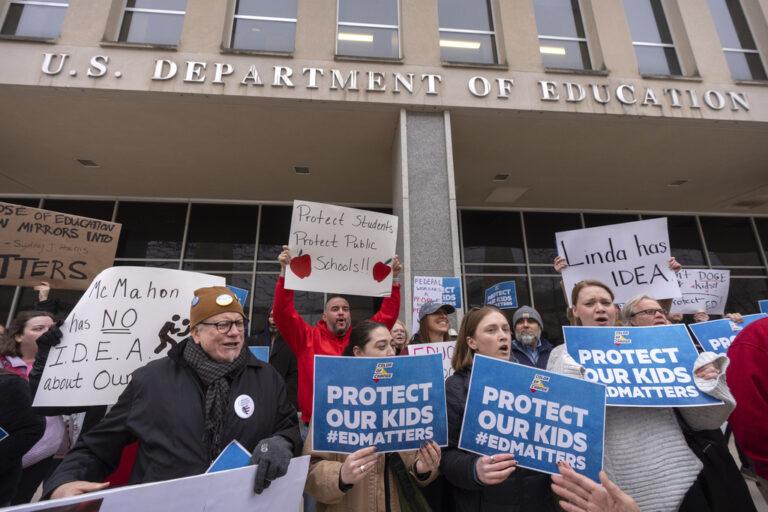As debates intensify over the future of federal education funding, concerns are mounting among students, parents, and educators about the potential impact of a government shake-up on local schools. With former President Donald Trump advocating for the closure of the U.S. Department of Education, questions arise about how such a move could affect the daily operations, resources, and policies of schools across the nation. This article explores what might happen at your school if the Department of Education is dismantled, examining the implications for funding, federal oversight, and educational equity.
Impact on School Funding and Resources Across Districts
Eliminating the Department of Education would prompt significant financial disruption across school districts nationwide. Without the federal oversight and funding streams that the department manages, many districtsŌĆöespecially those in low-income or rural areasŌĆöwould face drastic budget cuts. This reduction could translate into fewer classroom resources, diminished special education support, and a scaling back of after-school programs that depend heavily on federal grants. Inequities between wealthy and under-resourced districts would only deepen as local governments scramble to fill the funding void or adjust to reduced federal aid.
Moreover, the impact would vary significantly by state and district, creating a patchwork of outcomes. Some districts might attempt to increase local taxes or seek private partnerships, while others could be forced to consolidate classes or lay off staff. Consider the following simplified comparison of potential funding changes:
| District Type | Current % Fed Funding | Possible Budget Change | Resource Impact |
|---|---|---|---|
| Urban Low-Income | 40% | -30% | Critical losses in tutoring and meals |
| Suburban Middle-Class | 15% | -10% | Reduction in extracurricular activities |
| Rural High-Poverty | 50% | -35% | Severe cuts to transportation and special ed |
- Federal grants for nutrition programs may disappear, affecting student health.
- Student loan and scholarship programs could face uncertainty, limiting access to higher education.
- Compliance and civil rights enforcement would lack centralized oversight, potentially increasing disparities.
Changes in Federal Oversight and Education Policy Enforcement
With the potential closure of the Department of Education, federal oversight of public schools would significantly diminish, leaving states and local districts to interpret and enforce education policies independently. This shift could lead to a patchwork of standards and enforcement practices, affecting accountability measures, student protections, and funding allocations traditionally overseen by federal bodies. Schools might experience delays or inconsistencies in implementing key programs related to civil rights, special education, and standardized testing, as the centralized regulatory authority would no longer exist to guide or intervene.
Key implications for schools could include:
- Reduced enforcement of federal guidelines on equity and inclusion
- Increased variability in curriculum and educational standards between states
- Potential disruption in federal funding streams critical for disadvantaged students
- Greater autonomy for local districts but with heightened responsibility for compliance
| Area Affected | Current Role of Department of Education | Post-Closure Scenario |
|---|---|---|
| Funding Distribution | Allocates grants and ensures equitable funds | State-level management with varied priorities |
| Policy Enforcement | Monitors compliance with federal laws | Local districts responsible with less oversight |
| Student Protections | Oversees civil rights and special education law adherence | Potential gaps in enforcement and reporting |
How Teachers and Administrators Might Adapt to Reduced Support
In the face of significant budget cuts and diminished federal oversight, educators and school leaders will be tasked with innovating local strategies to fill the support void. Teachers may increasingly rely on peer collaboration and community resources, pooling expertise to design curricula and share best practices without direct federal guidance. Professional development programs could pivot toward online platforms or district-led workshops, placing greater emphasis on flexibility and self-directed learning among staff.
Meanwhile, school administrators will need to sharpen their focus on resource management and advocacy. This could mean:
- Forging stronger partnerships with local businesses and nonprofits to supplement funding and programs.
- Increasing reliance on state education departments, which might require navigating varying regional regulations and policies.
- Implementing targeted budget audits to ensure the prioritization of critical student services.
| Support Area | Potential Adaptation | Expected Impact |
|---|---|---|
| Teacher Training | Local peer-led workshops | Increased collaboration, tailored learning |
| Funding | Community partnerships | Supplemented programs, diverse resources |
| Student Services | Prioritized budget allocation | Maintained critical supports despite cuts |
Steps Families Can Take to Navigate Uncertainty in Education Services
In times of uncertainty around education policy, families can take proactive steps to ensure their childrenŌĆÖs learning remains on track. First, open communication with your childŌĆÖs school is essential. Regularly reach out to teachers and administrators to stay informed about any changes or contingency plans that may arise. Engaging in school board meetings and local education forums can also empower families to voice concerns and understand the evolving landscape.
Additionally, diversifying educational resources can provide stability outside of traditional school environments. Consider supplementing learning with online platforms, community programs, or tutoring services. Creating a home learning schedule that mirrors regular school hours helps maintain routine and discipline. Below is a simple checklist families might find helpful:
- Maintain contact with school staff
- Participate in local education forums
- Use digital resources for supplemental learning
- Establish a consistent home learning routine
- Connect with community support networks
To Conclude
As the debate over the future of the Department of Education continues, uncertainty looms for schools across the nation. If the department were to close, local districts would face unprecedented challenges in funding, regulation, and support services. For students and educators, the potential changes could reshape the landscape of public education in profound ways. As policymakers consider the implications, communities will be closely watching to see how the federal role in education evolvesŌĆöand what that means for classrooms in every corner of America.




